Abstract
1 The central and peripheral cardiovascular effects of hydralazine and glyceryl trinitrate (GTN) have been contrasted using radionuclide techniques.
2 Following intravenous injection of technetium-99m labelled human serum albumin, radionuclide ventriculography was performed by the equilibrium blood pool method using a mobile gamma camera. Simultaneous measurements of `peripheral venous volume' were made using a collimated scintillation probe positioned above the patient's calf.
3 Ten patients with angina pectoris were studied at rest, after sublingual administration of 0.5 mg GTN and after intravenous administration of 10 mg hydralazine.
4 GTN caused a mean reduction in the end diastolic volume of the left ventricle of 14.6% ± 4.5% (P < 0.005) but ejection fraction increased by 0.034 ± 0.007 (P < 0.005) so that stroke volume was only reduced by 4.9% ± 5.0% (NS). There was a mean increase in heart rate of 10.8 ± 2.3 beats/min (P < 0.001) but no significant change in cardiac output. The calculated systemic vascular resistance fell by 10.0% ± 5.4% (P < 0.05). Associated with these changes there was a mean increase of 9.6% ± 1.5% (P < 0.05) in the counts from the calf.
5 Hydralazine caused a significant reduction in blood pressure and increase in heart rate. End-diastolic volume was reduced by 6.0% ± 2.7% but there was a mean increase in ejection fraction of 0.058 ± 0.010 (P < 0.001) so that in this instance stroke volume increased by 9.0% ± 3.7% (P < 0.05) and cardiac output increased by 16.4% ± 4.4% (P < 0.005). The calculated systemic vascular resistance fell by 18.9% ± 3.8% (P < 0.001). Despite these haemodynamic changes there was no significant change in counts from the calf.
6 The results confirm that GTN has a predominant venodilator effect while hydralazine acts largely on the arterial bed. These relatively simple radionuclide methods will allow a more detailed assessment of the cardiovascular effects of drugs.
Keywords: hydralazine, glyceryl trinitrate, radionuclide assessment, haemodynamics
Full text
PDF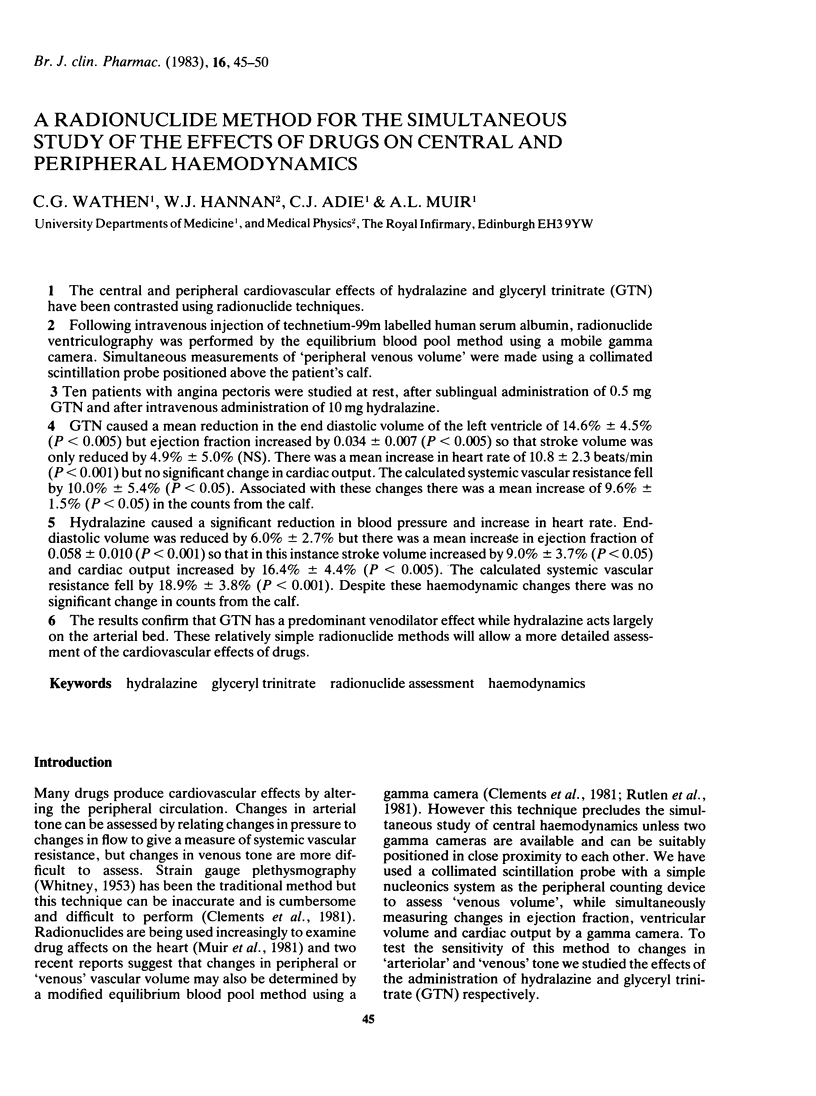
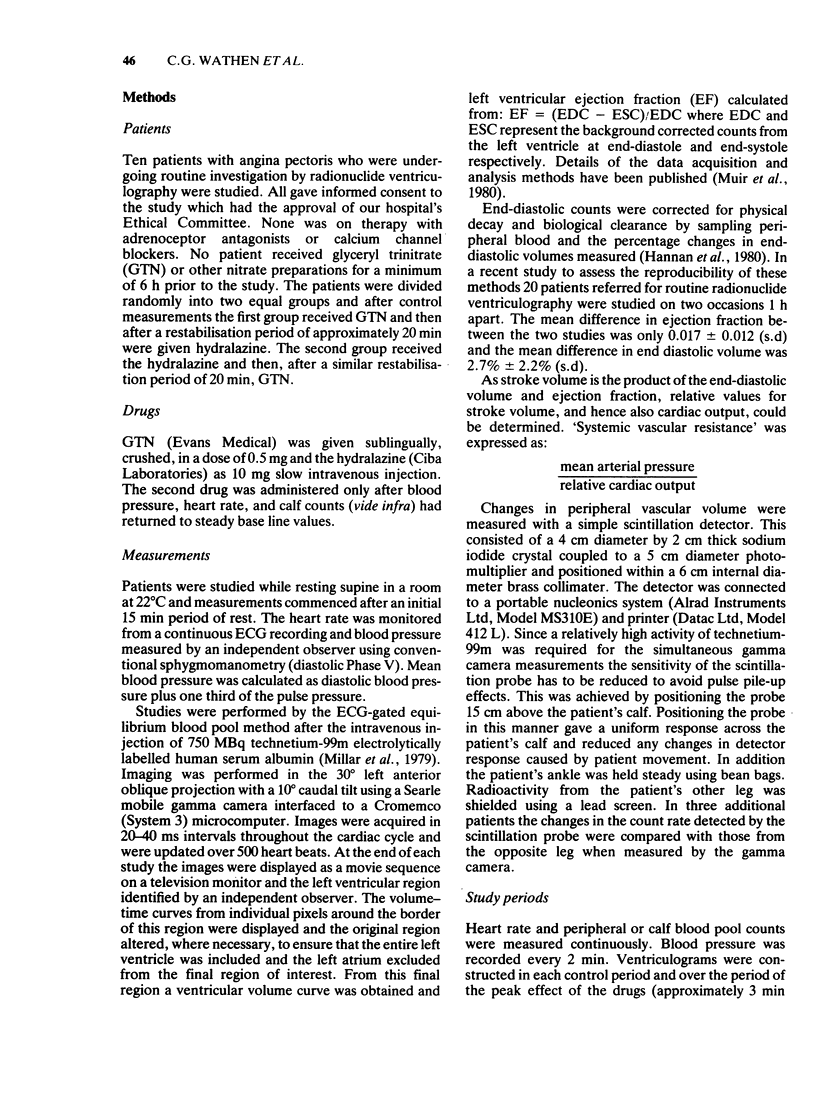
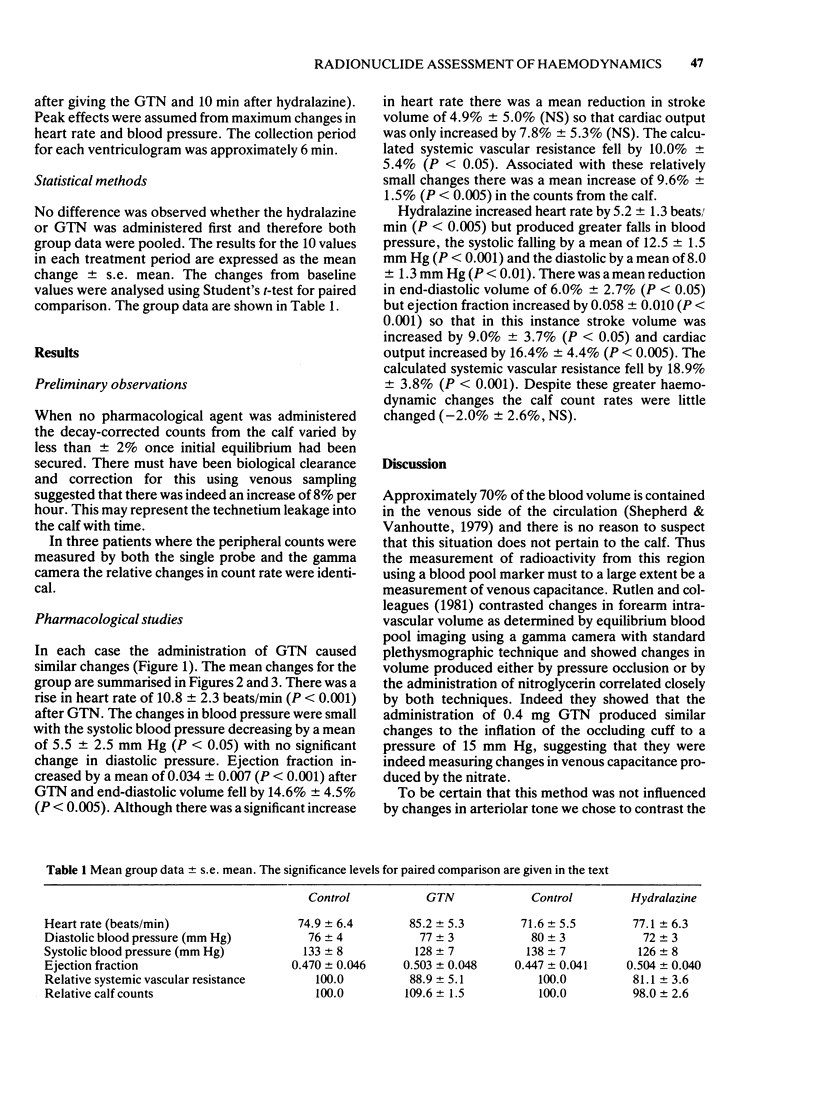
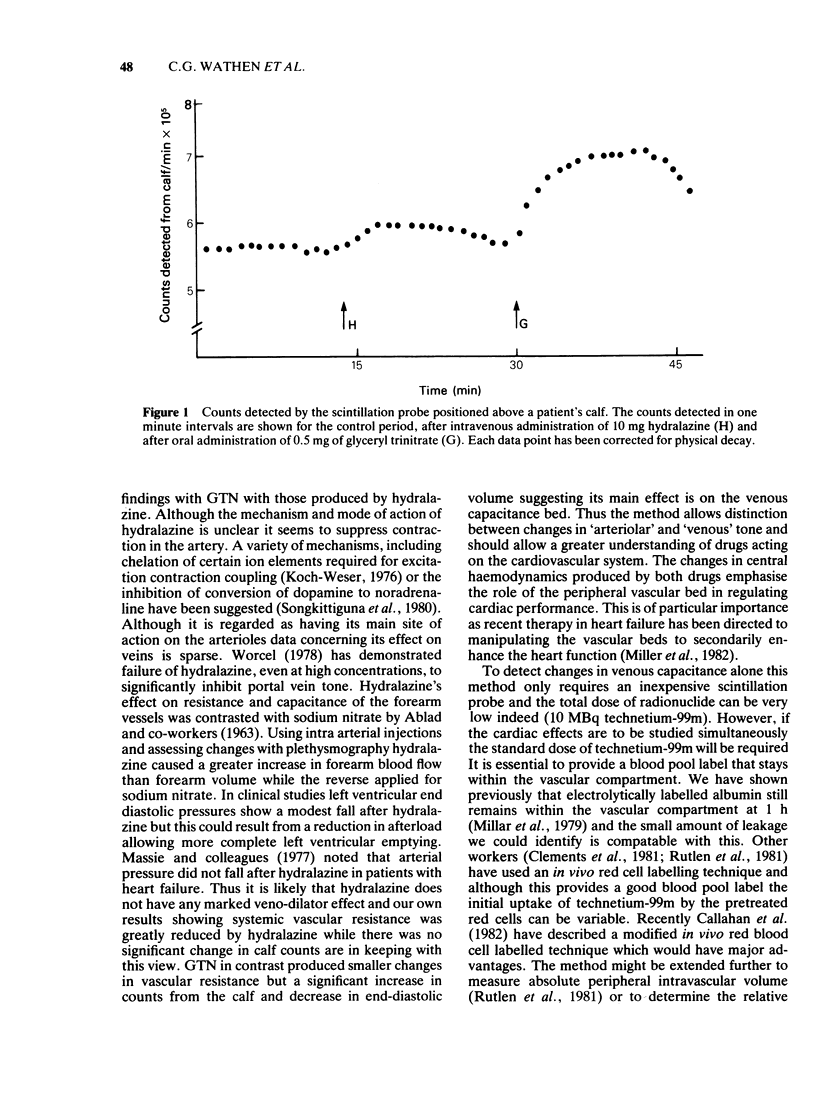
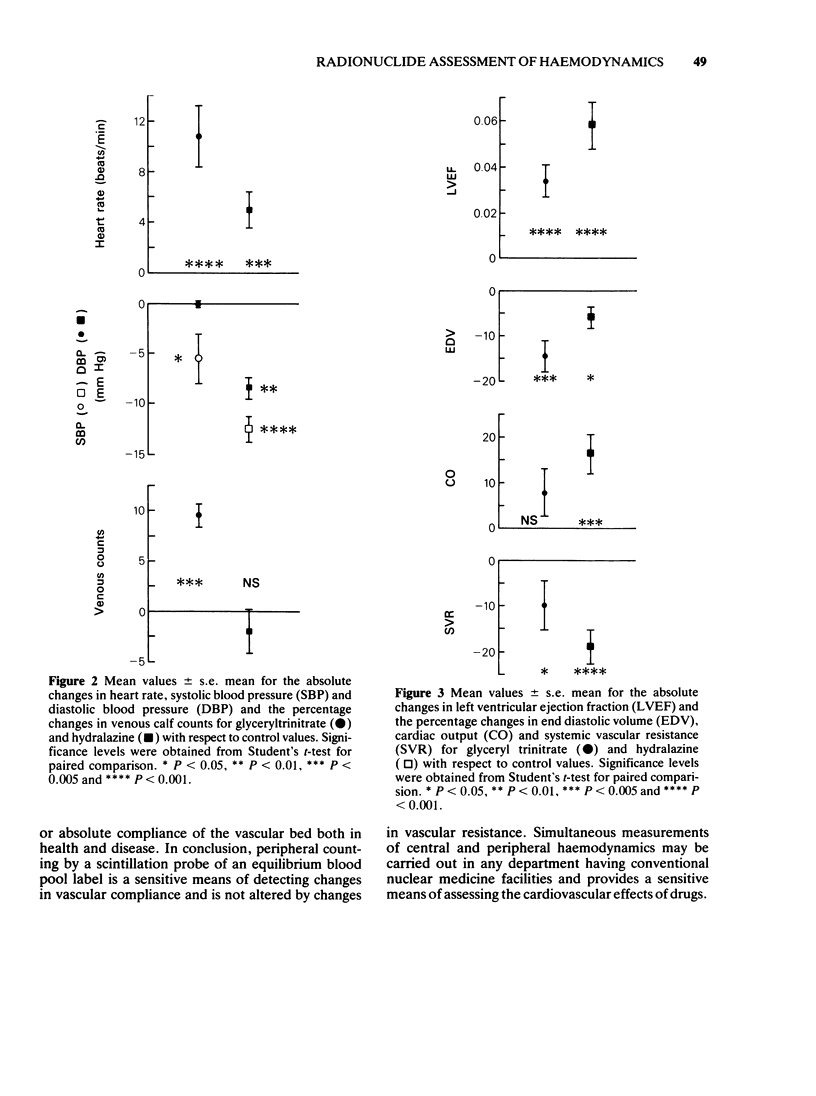
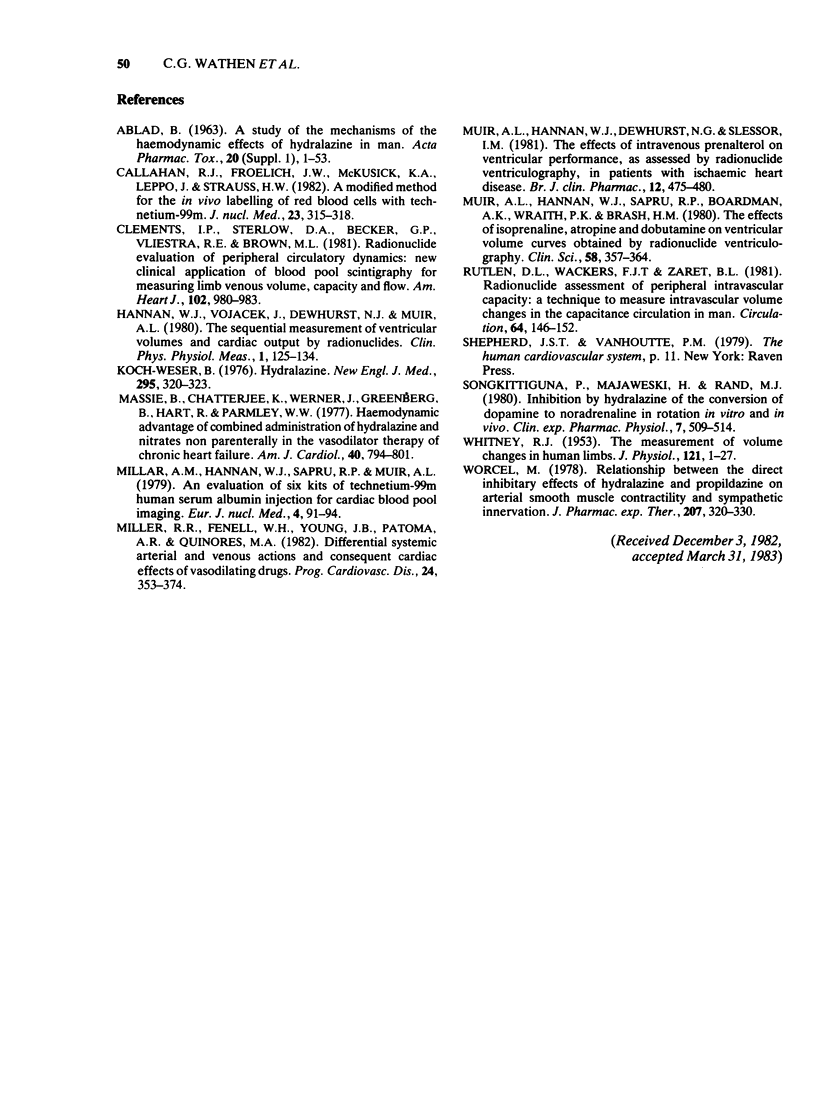
Selected References
These references are in PubMed. This may not be the complete list of references from this article.
- ABLAD B. A study of the mechanism of the hemodynamic effects of hydralazine in man. Acta Pharmacol Toxicol (Copenh) 1963;20(Suppl 1):1–53. [PubMed] [Google Scholar]
- Callahan R. J., Froelich J. W., McKusick K. A., Leppo J., Strauss H. W. A modified method for the in vivo labeling of red blood cells with Tc-99m: concise communication. J Nucl Med. 1982 Apr;23(4):315–318. [PubMed] [Google Scholar]
- Clements I. P., Strelow D. A., Becker G. P., Vlietstra R. E., Brown M. L. Radionuclide evaluation of peripheral circulatory dynamics: new clinical application of blood pool scintigraphy for measuring limb venous volume, capacity, and blood flow. Am Heart J. 1981 Dec;102(6 Pt 1):980–983. doi: 10.1016/0002-8703(81)90480-4. [DOI] [PubMed] [Google Scholar]
- Koch-Weser J. Medical intelligence drug therapy. N Engl J Med. 1976 Aug 5;295(6):320–323. doi: 10.1056/NEJM197608052950606. [DOI] [PubMed] [Google Scholar]
- Massie B., Chatterjee K., Werner J., Greenberg B., Hart R., Parmley W. W. Hemodynamic advantage of combined administration of hydralazine orally and nitrates nonparenterally in the vasodilator therapy of chronic heart failure. Am J Cardiol. 1977 Nov;40(5):794–801. doi: 10.1016/0002-9149(77)90199-0. [DOI] [PubMed] [Google Scholar]
- Millar A. M., Hannan W. J., Sapru R. P., Muir A. L. An evaluation of six kits of technetium 99m human serum albumin injection for cardiac blood pool imaging. Eur J Nucl Med. 1979 Apr 1;4(2):91–94. doi: 10.1007/BF00626077. [DOI] [PubMed] [Google Scholar]
- Miller R. R., Fennell W. H., Young J. B., Palomo A. R., Quinones M. A. Differential systemic arterial and venous actions and consequent cardiac effects of vasodilator drugs. Prog Cardiovasc Dis. 1982 Mar-Apr;24(5):353–374. doi: 10.1016/0033-0620(82)90019-6. [DOI] [PubMed] [Google Scholar]
- Muir A. L., Hannan W. J., Dewhurst N. G., Slessor I. M. The effects of intravenous prenalterol on ventricular performance, as assessed by radionuclide ventriculography, in patients with ischaemic heart disease. Br J Clin Pharmacol. 1981 Oct;12(4):475–480. doi: 10.1111/j.1365-2125.1981.tb01253.x. [DOI] [PMC free article] [PubMed] [Google Scholar]
- Muir A. L., Hannan W. J., Sapru R. P., Boardman A. K., Wraith P. K., Brash H. M. The effects of isoprenaline, atropine and dobutamine on ventricular volume curves obtained by radionuclide ventriculography. Clin Sci (Lond) 1980 May;58(5):357–364. doi: 10.1042/cs0580357. [DOI] [PubMed] [Google Scholar]
- Rutlen D. L., Wackers F. J., Zaret B. L. Radionuclide assessment of peripheral intravascular capacity: a technique to measure intravascular volume changes in the capacitance circulation in man. Circulation. 1981 Jul;64(1):146–152. doi: 10.1161/01.cir.64.1.146. [DOI] [PubMed] [Google Scholar]
- Songkittiguna P., Majewski H., Rand M. J. Inhibition by hydralazine of the conversion of dopamine to noradrenaline in rat atria in vitro and in vivo. Clin Exp Pharmacol Physiol. 1980 Sep-Oct;7(5):509–514. doi: 10.1111/j.1440-1681.1980.tb00101.x. [DOI] [PubMed] [Google Scholar]
- WHITNEY R. J. The measurement of volume changes in human limbs. J Physiol. 1953 Jul;121(1):1–27. doi: 10.1113/jphysiol.1953.sp004926. [DOI] [PMC free article] [PubMed] [Google Scholar]
- Worcel M. Relationship between the direct inhibitory effect of hydralazine and propildazine on arterial smooth muscle contractility and sympathetic innervation. J Pharmacol Exp Ther. 1978 Nov;207(2):320–330. [PubMed] [Google Scholar]


